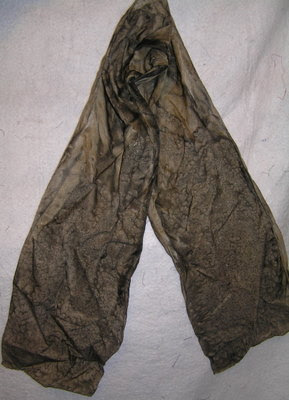Inspired by
Purple Missus's fantastic rust-dyeing results (
here,
here,
here,
here, and
here), I wanted to try this. Stay a while on Lynda's blog--she does some wonderful work with textures and color!
So I mixed up a pan of caustic tea (3 liters hot water with 50 tea bags) and 1 pan of iron water (250 grams iron mix with 3 liters warm water).
Note on the iron : I was not able to find Ferrous Sulphate (a plant fertilizer) locally. So I bought some "fast-acting iron" at Menards. It's got a few other things in it--like urea and pot-ash. But since these are familiar dyer's ingredients, I decided to give it a try. Here's the bag and the content mix :


After a few hours, both pans looked remarkably like the tea. I dipped the fabrics as described by Purple Missus. My fabrics wound up looking tea-stained rather than rust-stained. I hung them up to dry and oxidize for a week. Even after a week, they still seemed disappointing--more like old dirty rags than anything I'd want to use in a quilt. They looked a little better when I brought them upstairs for pictures ...
On Round 2, I ordered some Iron Sulphate from a garden center out west. No one in my area carries it--we have plenty of naturally-occurring iron in The Rust Belt. What arrived in the package was Bonide Root Rot Stopper. Hmmmh ... they shipped the wrong item. Fate made me wait again. It was another week before the right stuff came. Here's the iron sulphate :


Obviously, there is a difference in the content of the mixtures. I thought perhaps that was the difference in the results I got vs. Purple Missus gorgeous colors. Nope--there's something else going on ... maybe with additives in my local water supply?
Here's what I got with Round 1 (with the Fast Acting Iron mix) before washing :





Here's what I got on Round 2 with the actual Iron Sulphate :

This one was Lois Jarvis' storm clouds method with bits of tea sprinkled on the fabric along with the iron. This is dramatic, and could warrant more experimenting ... Maybe if I ground up the iron into a dust or powder rather than using the pellets? Lois Jarvis explains it in this
interview with Bonnie McCaffery. I actually purchased
one of her scarves in April.



These actually look better in the pictures than they do in real life. These are the more interesting ones. Most of the Round 2 fabs came out looking like old rags that ought to be retired.
Maybe I'll just put these away for a while. They might look better to me in a few months ...
Here's another thought --if it's iron I need for this project, why not use Blood Meal?
All this experimenting--some with disappointing results--makes me realize that I may be squandering my time and effort away on all these other sidelines. It takes time away from what I am good at--Art Quilts. Ah, but summer is supposed to be too hot to be in the sewing room. Summer is the time to retreat to the cool basement.
At that point, here are my options :
1) Ask Purple Missus for a sample of her dreamy results
2) Ask Lois Jarvis (of
Rust-Tex) where to get the iron powder
3) Order Lois's CD and learn to do it for Midwest conditions. I know she has meticulously researched this, and has only methods for reproduce-able results on her CD
4) Give up on Rust-dyeing altogether
5) Continue to experiment - Over-dye these with more rust or Pro-Chem dyes










































